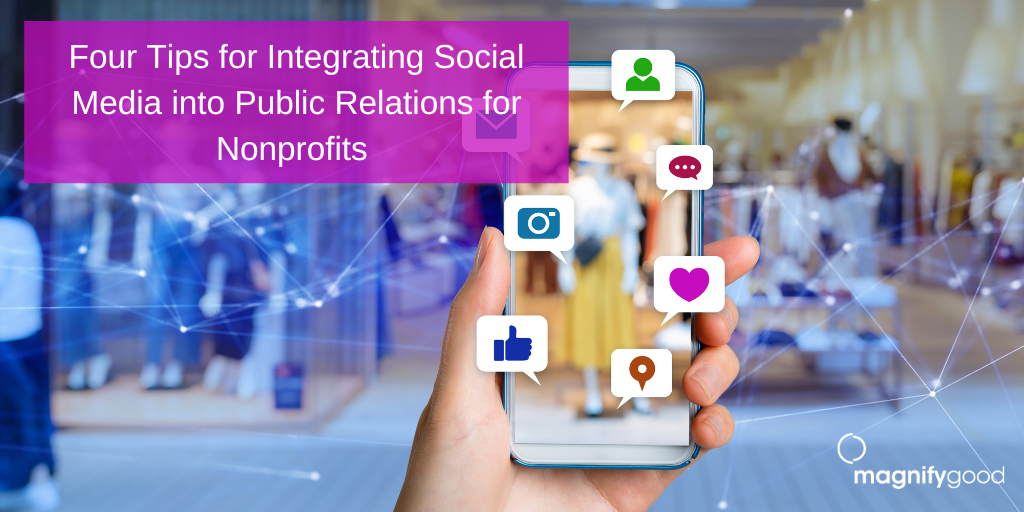The use of social media in public relations has become increasingly important for nonprofits. As the 24-hour news cycle and shrinking attention spans have made it more difficult for organizations to get their message out through traditional channels, using platforms like Twitter, Facebook, Instagram, and even TikTok provides a way to reach potential supporters directly.
While some may view social media only as a platform for promoting awareness or generating funds, it can also be used to manage reputation, cultivate relationships, and deepen engagement with existing supporters. In this blog post, we’ll explore four different ways that nonprofits can use social media in their public relations efforts.
1) Integrate social media into your public relations strategies.
Integrating social media into a nonprofit organization’s public relations strategy is essential for success. Social media provides an opportunity to reach a wider audience, build trust within the community, share and promote programs, events, and resources. Nonprofits should consider where their audiences are looking for information,what social media channels are most frequently used by them, and what channels best match the mission and brand identity of the organization, and prioritize accounts on those platforms in order to maximize their outreach and visibility.
Having a presence on social media is critical for nonprofits to build a strong brand reputation and stay apprised of relevant conversations happening online that can be used as an opportunity to engage. Social media is also a great tool for nonprofits to engage with partners and organizations similar to theirs in order to expand their visibility with new audiences.
2) Be consistent.
To get the most impact from using social media in public relations, be consistent. Consistency means showing up with regular posts and engaging with your audience. As reported by Hootsuite, Facebook and Instagram algorithms prioritize sharing content with users from accounts that frequently post. It’s also critical to be consistent with your brand voice and tone. Sharing content across platforms with one clear organizational voice helps strengthen your organization’s credibility and improves the effectiveness of your calls to action. One helpful approach to ensuring consistency is establishing a monthly content calendar that includes social media posts for each platform.
Consistently engaging with your organization’s audiences on social media is an essential way to build a positive brand reputation. This looks like responding to comments on your posts and others, answering direct messages in a timely manner, and liking and/or sharing relevant content from partners or other similar organizations. By engaging with their followers on social media, nonprofits can create meaningful connections and foster a sense of community. Through these interactions, nonprofits can gain valuable insights into their target audience and develop strategies to better serve them. Social media engagement also helps nonprofits increase visibility and reach more potential donors and volunteers.
3) Use social media to monitor news about your organization and inform media outreach.
Social media has become an increasingly popular way to stay up to date with news and media. Pew Research Center reported in 2022 that half of U.S. adults get news at least sometimes from social media. With platforms like Twitter, Facebook, Instagram and LinkedIn offering round-the-clock updates on news stories, it’s easy to keep up with the latest developments. For brands, social media can be used for monitoring of their own reputation online as well as competitor analysis.
Social media can also be used as a tool to find story and media pitch ideas. Searching for relevant keywords and topics related to the nonprofit organization and its mission can help identify stories or insights to inform media relations strategies and pitches. Additionally, social media is an integral tool for monitoring conversations about key topics and relevant trends to better understand public sentiment.
4) Build relationships.
Nonprofits can use social media to build relationships with journalists. By engaging in conversations on topics related to the organization’s mission, nonprofits can put themselves in a position to be seen as trusted sources for news stories and interviews. Following and actively participating in conversations about topics that are relevant to their cause can also help nonprofits establish trust and connection with reporters and bloggers, making them more likely to cover their story. And sharing valuable content from other individuals or entities can build goodwill towards the organization, helping it further its mission.
Using social media effectively is a crucial part of nonprofit public relations. By leveraging the power of social media, nonprofits can increase visibility, foster meaningful connections and gain valuable insights into their target audience. Additionally, by engaging in conversations on topics related to their mission, nonprofits can establish relationships and build trust with reporters and bloggers to help them further their cause. Taking advantage of the opportunities offered through social media can have a positive impact on any nonprofit’s public relations strategy.



